 |
|
|
 |
 |




















|
 |
|
 |

A Carthaginian army can draw upon various troop types with an wider selection of spear & pike infantry, various cavalry and skirmishing infantry.
From it's home provinces it can recruit spearmen, elite pikemen, assault infantry & heavy cavalry in addition to Numidians as skirmisher infantry & cavalry. From Iberia and the Balearic Isles a Carthaginian general has access to good quality troops for almost any battlefield role, from light infantry to elite slingers to heavy cavalry. And Karthadastim can recruit other troops from Gaul, Italy and beyond as well, meaning a Carthaginian army can have a massive difference in units when it comes to nationality and fighting style.
Poeni Citizen Militia - Mishteret Izrahim Feenikim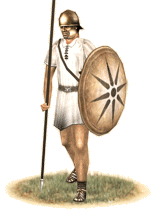 The Phoenician citizens of Carthage decided long ago that they were too few in number to make up a major part of the regular army of the city. Their wealth made it possible for them to hire vast amounts of mercenaries to fight for them. Because of this, most Carthaginian citizens only fight when there is a need for the defense of Carthage itself. When they do fight, they fight as a militia phalanx. They wear linen tunics and attic style helmets, copied from the Greeks of Sicily. The Carthaginian citizens still use the round bronze hoplon-style shield to protect themselves. Still, they are militia, and should not be expected to hold crucial portions of the battle line for any significant amount of time. They are brave, but it is a bravery borne of desperation. They will not hold long if flanked or if hit with a better Phalanx. The Phoenician citizens of Carthage decided long ago that they were too few in number to make up a major part of the regular army of the city. Their wealth made it possible for them to hire vast amounts of mercenaries to fight for them. Because of this, most Carthaginian citizens only fight when there is a need for the defense of Carthage itself. When they do fight, they fight as a militia phalanx. They wear linen tunics and attic style helmets, copied from the Greeks of Sicily. The Carthaginian citizens still use the round bronze hoplon-style shield to protect themselves. Still, they are militia, and should not be expected to hold crucial portions of the battle line for any significant amount of time. They are brave, but it is a bravery borne of desperation. They will not hold long if flanked or if hit with a better Phalanx.
Historically, a Carthaginian citizen phalanx was of poor quality. They lived pampered lifestyles in comparison to citizens of other nations, and their abilities reflect this. Carthage did not use citizens outside of elite military units unless there was a dire need to do so. They were used during the Roman invasion in the first Punic War and at the battle of Zama to little effect. Citizens who wished a martial career could join the cavalry or the Sacred Bands. There was little incentive for merchants to fight wars...
Carthaginian Citizen Cavalry - Ezrahim Parashim Feenikim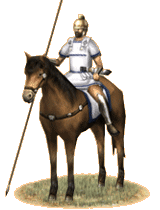 Carthaginian citizens have a tradition of fine cavalry from the lower nobility, and these men are the embodiment of that tradition. They are good horsemen with good equipment, enough to put them on a par with most other medium cavalry. They are armed with a lance (a Greek xyston), which makes their charge deadly in the extreme. They are disciplined and have high morale, for they are fighting for their homeland. For all this, they cannot stand up against heavier cavalry or good spearmen for very long, due to their lack of a shield and their light linen armor. They are best used as a medium shock cavalry, and since their fast horses are crossbreeds of Iberian and Numidian breeds, they are able to run down most fleeing soldiers. Carthaginian citizens have a tradition of fine cavalry from the lower nobility, and these men are the embodiment of that tradition. They are good horsemen with good equipment, enough to put them on a par with most other medium cavalry. They are armed with a lance (a Greek xyston), which makes their charge deadly in the extreme. They are disciplined and have high morale, for they are fighting for their homeland. For all this, they cannot stand up against heavier cavalry or good spearmen for very long, due to their lack of a shield and their light linen armor. They are best used as a medium shock cavalry, and since their fast horses are crossbreeds of Iberian and Numidian breeds, they are able to run down most fleeing soldiers.
Historically, these men were of great use in the Mammertine War that followed the first Punic War. They were able to hold the flanks at tremendous odds. They were a well trained group of lancers who formed a reliable medium cavalry for the Carthaginian State.
Libyan Spearmen (early) - Aanatim Leebim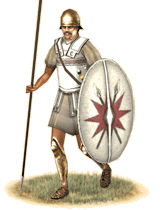 Due to the practical unwillingness of its citizen body to fight, the Carthaginians have trained and equipped these Lybian peasants to fight as reliable spearmen. They are armored with good linen and do not tire easily. Their shields and fighting skill make them a tough defensive nut to crack. For all this, they are no match for heavier infantry or good heavy cavalry. They can be relied upon as light defensive infantry, but asking more than this of them might be asking too much. Due to the practical unwillingness of its citizen body to fight, the Carthaginians have trained and equipped these Lybian peasants to fight as reliable spearmen. They are armored with good linen and do not tire easily. Their shields and fighting skill make them a tough defensive nut to crack. For all this, they are no match for heavier infantry or good heavy cavalry. They can be relied upon as light defensive infantry, but asking more than this of them might be asking too much.
Historically, Lybian spearmen were recruited by the Carthaginians in large numbers. They came from both client kingdoms under the proverbial Carthaginian thumb and the Libyan peasantry that worked Carthage’s fields. They were not particularly prone to rebellion and civil strife, but there are notable exceptions (after the first Punic War, for example). Carthage relied upon these men quite extensively, and they usually formed the backbone of the infantry when Carthage conducted campaigns in Africa.
Libyan Heavy Spearmen (late) - Aanatim Leebim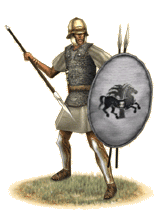 It was an odd development that produced the Libyan Thorakitai. At virtually the same time, though at different places, both Carthage and the Greeks realized that a heavier version of the standard Thureophoroi would be a versatile and useful unit to have around. The most veteran and loyal of the Libyans were gathered and re-equipped with heavier javelins and a mail shirt. This, combined with their veteran status makes them excellent soldiers, well able to stand up to any enemy. They are best used as a heavy shock infantry, with the lighter Libyan soldiers supporting. It was an odd development that produced the Libyan Thorakitai. At virtually the same time, though at different places, both Carthage and the Greeks realized that a heavier version of the standard Thureophoroi would be a versatile and useful unit to have around. The most veteran and loyal of the Libyans were gathered and re-equipped with heavier javelins and a mail shirt. This, combined with their veteran status makes them excellent soldiers, well able to stand up to any enemy. They are best used as a heavy shock infantry, with the lighter Libyan soldiers supporting.
Historically, the better Libyan warriors were given heavier armor by their commanders. They often fought with distinction alongside their more elite and more heavily armored compatriots, the elite African Infantry. They were a heavy infantry of wonderful quality, able to stand up to Romans and Greeks with ferocity and equal equipment.
Liby-Phoenician Infantry (early) - Dorki Leebi-Feenikim Mookdamim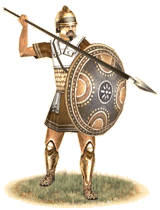 The Liby-Phoenicians are a result of a mixing of Phoenician and Libyan races, and are the product of many a Phoenician lord ‘dallying’ with his peasants and slaves. There were a huge number of these half-breed men, so the Carthaginians used them in the army. They were armed and armored much the same as their Greek enemies on Sicily. They were armored in a linen cuirass, Thracian helmets, and bronze greaves. They have the traditional round shield of the Greek hoplite, but use longer spears with the underhand thrust, much like the reformed hoplites of the Greek mainland. They are a quality phalanx, able to stand up to both Romans and their Greek counterparts. They lack the heavy armor necessary to provide a huge amount of staying power on the battlefield against heavier infantry, however. This is a problem that led to the adoption of mail armor later. The Liby-Phoenicians are a result of a mixing of Phoenician and Libyan races, and are the product of many a Phoenician lord ‘dallying’ with his peasants and slaves. There were a huge number of these half-breed men, so the Carthaginians used them in the army. They were armed and armored much the same as their Greek enemies on Sicily. They were armored in a linen cuirass, Thracian helmets, and bronze greaves. They have the traditional round shield of the Greek hoplite, but use longer spears with the underhand thrust, much like the reformed hoplites of the Greek mainland. They are a quality phalanx, able to stand up to both Romans and their Greek counterparts. They lack the heavy armor necessary to provide a huge amount of staying power on the battlefield against heavier infantry, however. This is a problem that led to the adoption of mail armor later.
Historically, the Liby-Phoenicians were present at every major battle of the Carthaginian wars. They gave good accounts of themselves against Romans, Libyans, Italians, Greeks, and Iberians. They were and are great phalanx spearmen, well able to stand up to most other regular infantry. They were later armored with captured or copied Roman style armor.
Liby-Phoenician Heavy Infantry (late) - Dorki Leebi-Feenikim Meshoorianim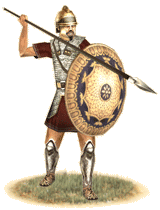 The Liby-Phoenicians are a result of a mixing of Phoenician and Libyan races, and are the product of many a Phoenician lord ‘dallying’ with his peasants and slaves. There were a huge number of these half-breed men, so the Carthaginians used them in the army. They were armed and armored much the same as their Greek enemies on Sicily. They were armored in a mail shirt, Thracian helmets, and bronze greaves. They have the traditional round shield of the Greek hoplite, but use longer spears with the underhand thrust, much like the reformed hoplites of the Greek mainland. They are a quality phalanx, able to stand up to both Romans and their Greek counterparts. These Liby-Phoenicians have been re-armed with mail shirts, allowing them to take a role as a heavy phalanx infantry. Additionally, their training has improved due to Greek advisors and better Phoenician commanders, so they are well able to double as sword-armed close combat infantry as well. The Liby-Phoenicians are a result of a mixing of Phoenician and Libyan races, and are the product of many a Phoenician lord ‘dallying’ with his peasants and slaves. There were a huge number of these half-breed men, so the Carthaginians used them in the army. They were armed and armored much the same as their Greek enemies on Sicily. They were armored in a mail shirt, Thracian helmets, and bronze greaves. They have the traditional round shield of the Greek hoplite, but use longer spears with the underhand thrust, much like the reformed hoplites of the Greek mainland. They are a quality phalanx, able to stand up to both Romans and their Greek counterparts. These Liby-Phoenicians have been re-armed with mail shirts, allowing them to take a role as a heavy phalanx infantry. Additionally, their training has improved due to Greek advisors and better Phoenician commanders, so they are well able to double as sword-armed close combat infantry as well.
Historically, the Liby-Phoenicians were present at every major battle of the Carthaginian wars. They gave good accounts of themselves against Romans, Libyans, Italians, Greeks, and Iberians. They were and are great phalanx spearmen, well able to stand up to most other regular infantry. They were later armored with captured or copied Roman style armor.
Dorkim Leebi-Feenikim Aloophim (Elite Liby-Phoenician Infantry)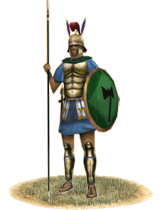 Liby-Phoenicians are described as a mixed race, half Punic and half African. A mixture of colonial and native blood, they first lived in Carthaginian colonies in Africa such as Utica or Hadrumentum. Around the fifth century BC, the Liby-Phoenicians started to be found in other Carthaginian settlements around the Mediterranean, like Iberia and Sicily, as they were used to increase the population in those colonies.
Liby-Phoenicians are described as a mixed race, half Punic and half African. A mixture of colonial and native blood, they first lived in Carthaginian colonies in Africa such as Utica or Hadrumentum. Around the fifth century BC, the Liby-Phoenicians started to be found in other Carthaginian settlements around the Mediterranean, like Iberia and Sicily, as they were used to increase the population in those colonies.
The Liby-Phoenician population shared many features and traits with the Carthaginian citizens, but they didn’t have the same rights. Unlike Carthaginian citizens, Liby-Phoenicians were a very common sight in the armies of Carthage.
Though they are armed with the traditional hoplite shield and spear like other Carthaginian troops, these elite warriors are armored with a metal cuirass, and a Libyan axe as their secondary weapon for close combat. They are very versatile and can be also found deployed as seaborne land soldiers in the Carthaginian navy. Their heavy armor and weapons allow them to battle the hardiest opponents. They should be deployed where the fighting will be at its absolute thickest, as they are able to charge in for a kill once the enemy has exhausted himself upon the unforgiving points of their spears and axes.
Historically, the Liby-Phoenicians were present at every major battle of the Carthaginian wars. They gave good accounts of themselves against Romans, Libyans, Italians, Greeks, and Iberians. They were and are great phalanx spearmen, well able to stand up to most other regular infantry.
Parasim Lebiponnim (Liby-Phoenician Cavalry)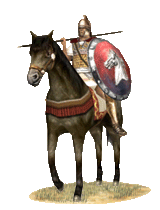 Shofet! These are the finest sons of Phoenician noblemen and the prettiest of the local Libyan girls. They were brought up far better than bastards deserve, and now serve as fine cavalry. They are extremely well disciplined, since they are naught but the best regular soldiers Kart-Hadast has to offer. Armored in fine scale and linen, they can last long in a melee after charging home with their lances. A fine helmet augments this protection, as do boots copied from the Makedonians. Shofet! These are the finest sons of Phoenician noblemen and the prettiest of the local Libyan girls. They were brought up far better than bastards deserve, and now serve as fine cavalry. They are extremely well disciplined, since they are naught but the best regular soldiers Kart-Hadast has to offer. Armored in fine scale and linen, they can last long in a melee after charging home with their lances. A fine helmet augments this protection, as do boots copied from the Makedonians.
Elite African Infantry - Dorkim Afrikanim Aloophim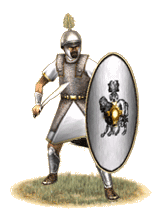 The Elite African Infantry represent both an adaptation to Roman tactics, and a force of extremely well trained and motivated soldiers whose purpose is to fight as a tough and seasoned heavy infantry. They wield good Iberian short swords, carry Iberian Scuta, and wear Roman mail armor with greaves and bracers. They fight much like Roman legionaries, but with a level of Élan and discipline rarely seen in any army. They’re made up of tough Liby-Phoenicians or poor Carthaginian citizens who made a career for themselves in the Army. They’re extremely loyal and simply vicious in attack or defense. They are also experts at ambushing enemy soldiers. These men are at the top of their class, and can be relied upon in any situation. If they have one weakness it is the same as the Roman soldiers they most often fight, heavy cavalry. The Elite African Infantry represent both an adaptation to Roman tactics, and a force of extremely well trained and motivated soldiers whose purpose is to fight as a tough and seasoned heavy infantry. They wield good Iberian short swords, carry Iberian Scuta, and wear Roman mail armor with greaves and bracers. They fight much like Roman legionaries, but with a level of Élan and discipline rarely seen in any army. They’re made up of tough Liby-Phoenicians or poor Carthaginian citizens who made a career for themselves in the Army. They’re extremely loyal and simply vicious in attack or defense. They are also experts at ambushing enemy soldiers. These men are at the top of their class, and can be relied upon in any situation. If they have one weakness it is the same as the Roman soldiers they most often fight, heavy cavalry.
Historically, these men were used to great effect in the momentous battle of Cannae. They surrounded and slaughtered the Roman soldiers in what is today recognized as the classic double envelopment. Without the tremendous skill and élan that these men were possessed of, it would simply have been impossible. Their heavy handed guerilla tactics proved to be a constant thorn in the Roman side. They were deserving of the moniker that Livy gave them: ‘The flower of the Carthaginian army’.
Elite African Pikeman - Aanatim Afrikanim Aloophim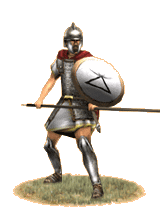 The Elite African Pikeman are two things: an elite infantry of picked men and a reply to the Successor's tactics. Although recruited from the Carthaginian population to be part of their infantry, these men are the ones that distinguished themselves in battle in many ocasions. As very experienced and prized veterans, they are supported by the state, and as such, have extremely good equipment. Like most of the Successor's battle line, they fight as Macedonian-style phalangites weilding the long sarissae. They are a nearly impervious wall from the front, and, although like any phalangite unit, vulnerable from the sides or back, can hold their own in closer combat due to their proficiency with swords. Even the heaviest cavalry is no match for the Elite African Pikeman as long as they’re presenting their spears in the direction of their attacker. Only a flanking maneuver by heavy cavalry or heavy infantry has a chance of breaking them in a melee. The Elite African Pikeman are two things: an elite infantry of picked men and a reply to the Successor's tactics. Although recruited from the Carthaginian population to be part of their infantry, these men are the ones that distinguished themselves in battle in many ocasions. As very experienced and prized veterans, they are supported by the state, and as such, have extremely good equipment. Like most of the Successor's battle line, they fight as Macedonian-style phalangites weilding the long sarissae. They are a nearly impervious wall from the front, and, although like any phalangite unit, vulnerable from the sides or back, can hold their own in closer combat due to their proficiency with swords. Even the heaviest cavalry is no match for the Elite African Pikeman as long as they’re presenting their spears in the direction of their attacker. Only a flanking maneuver by heavy cavalry or heavy infantry has a chance of breaking them in a melee.
Historically, together with the famed Elite African Infantry, these men were used to great effect in many important battles. Their imperviousness, esprit de corps and élan secured many times the Carthaginian line. Their rareness did not allow them to distinguish themselves in more situations against the Roman opponent. Had they been trained in greater quantities and used in a more frequent and supported role, history would, perhaps, say otherwise. In any event, they were deserving of the moniker that Livy gave to their bretheren: ‘The flower of the Carthaginian army’.
Iberian Assault Infantry - Dorkei Hatkafa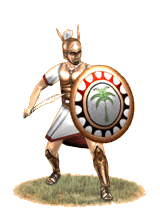 During the Second Punic War, Hannibal found that the Italian troops under his command were less than able to be trusted with the capture of important strategic areas. Thus, he undertook to amend the training of some of his Iberian and Balearic troops in order to provide good assault infantry. They were equipped with the standard fare of assault troops, large round shields and javelins. They kept their falcatae, but gained new iron armor and helmets made in the Bruttian style. These troops can be called upon as an elite assault infantry that will be ideally suited to taking fortresses and smashing into enemy troops. During the Second Punic War, Hannibal found that the Italian troops under his command were less than able to be trusted with the capture of important strategic areas. Thus, he undertook to amend the training of some of his Iberian and Balearic troops in order to provide good assault infantry. They were equipped with the standard fare of assault troops, large round shields and javelins. They kept their falcatae, but gained new iron armor and helmets made in the Bruttian style. These troops can be called upon as an elite assault infantry that will be ideally suited to taking fortresses and smashing into enemy troops.
Historically, the capture of many Italian cities was due to these hardy and elite troops. Iberian assault troops, together with the elite of Hannibal’s Gallic infantry, took Tarentum with very little bloodshed. They were used and trained primarily during the Second Punic War, but a wily Carthaginian general could use them to great effect earlier, provided he has the necessary know-how and facilities. Assault infantry were something lacked by the Carthaginian armies earlier, but were well within reach by the time of the Punic Wars.
Dorkim Kdoshim - (Sacred Band Phalanx)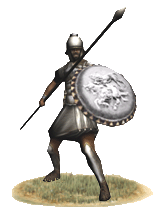 The Sacred Band are an elite infantry of a different kind than the Elite Africans. Trained from a young age to be tough phalanx spearmen, these men are from wealthy Kart-hadastim families, and as such have extremely good equipment. They are trained from birth to be great warriors and they are able to afford high quality armor and weapons. They fight as a traditional Phalanx organized in the Spartan style. They are a nearly impervious wall from the front and are extremely hard to flank due to the fact that they are as proficient with their swords as with their spears. Even the heaviest cavalry is no match for the Sacred Band as long as they’re presenting their spears in the direction of their attacker. Only a flanking maneuver by heavy cavalry or heavy infantry has a chance of breaking them in a melee. They are proficient with their swords as well, often able to provide an elite assault infantry when required. Though they’re really too heavy for the role, but can excel as a shock infantry when needed. The Sacred Band are an elite infantry of a different kind than the Elite Africans. Trained from a young age to be tough phalanx spearmen, these men are from wealthy Kart-hadastim families, and as such have extremely good equipment. They are trained from birth to be great warriors and they are able to afford high quality armor and weapons. They fight as a traditional Phalanx organized in the Spartan style. They are a nearly impervious wall from the front and are extremely hard to flank due to the fact that they are as proficient with their swords as with their spears. Even the heaviest cavalry is no match for the Sacred Band as long as they’re presenting their spears in the direction of their attacker. Only a flanking maneuver by heavy cavalry or heavy infantry has a chance of breaking them in a melee. They are proficient with their swords as well, often able to provide an elite assault infantry when required. Though they’re really too heavy for the role, but can excel as a shock infantry when needed.
The Sacred Band was a group of soldiers that were dedicated to Baal, the great father God of the Phoenician/Canaanite pantheon. They were all members of the nobility, and were called upon to fight their country’s wars as an elite unit that formed the right wing of the phalanx. They were all slaughtered in Sicily by the armies of Syracuse in the fifth century BC, but many records speak of an elite unit that fought on the right wing of the Phalanx long after their demise. Perhaps the Kart-hadastim simply did not wish to tempt fate with a name like the Sacred Band again…
Ha'Abbirim Ha'Qdosim sel Astarte (Sacred Band Cavalry)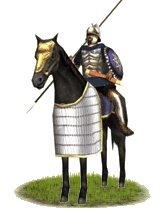 The Sacred Band Cavalry are trained from birth to be a superb heavy cavalry force. Their superbly bred Iberian horses are barded with fine lacquered lamellar and are trained by the finest Iberian horse trainers. The men themselves are picked at birth from noble families to serve the priesthood of Astarte and are trained from the outset as horsemen. Their training and discipline is such that they can be included among the world’s finest heavy cavalry. Armed with finely forged lances and falcate swords they are nearly irresistible in the charge and versatile in melee, though not so versatile as the heavy Iberian cavalry. They usually do not use the shield in mounted combat, preferring to sling it over the shoulder and use both hands to manipulate their fearsome lance. Their lack of a shield is made up for by their superb training and fine lacquered steel breastplates, bracers and greaves. They fight with a level of élan and ferocity that is seldom matched, if ever. The Sacred Band Cavalry are trained from birth to be a superb heavy cavalry force. Their superbly bred Iberian horses are barded with fine lacquered lamellar and are trained by the finest Iberian horse trainers. The men themselves are picked at birth from noble families to serve the priesthood of Astarte and are trained from the outset as horsemen. Their training and discipline is such that they can be included among the world’s finest heavy cavalry. Armed with finely forged lances and falcate swords they are nearly irresistible in the charge and versatile in melee, though not so versatile as the heavy Iberian cavalry. They usually do not use the shield in mounted combat, preferring to sling it over the shoulder and use both hands to manipulate their fearsome lance. Their lack of a shield is made up for by their superb training and fine lacquered steel breastplates, bracers and greaves. They fight with a level of élan and ferocity that is seldom matched, if ever.
Historically, these men served in small units during every one of Carthage’s major campaigns. They were kept out of the battle of Zama due to the machinations of the anti-Barcid party in the Senate. Had the thousand strong Sacred Band been present, the battle might have turned out very different…
Elephantes Hulaioi Liboukoi (Forest Elephants)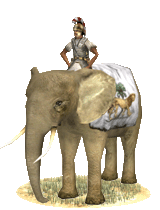 Imported from the regions far south of Aigyptos or from the mountain forests of northwestern Africa, forest elephants are an exceptionally valuable resource in combat, used mainly by the Ptolemaioi and Qarthadastim. Towering over most other creatures, they can easily scare men and horses alike, with both their size and smell, though elaborate bells and trappings often add to their intimidation. Such corps are directed by their own mahouts riding behind their heads, often a native of their own country who has spent at least two years training his beast from capture. The mahout is armored to better protect against the obvious assault that generally comes against him, launched to bypass the thick natural armor of his mount. Imported from the regions far south of Aigyptos or from the mountain forests of northwestern Africa, forest elephants are an exceptionally valuable resource in combat, used mainly by the Ptolemaioi and Qarthadastim. Towering over most other creatures, they can easily scare men and horses alike, with both their size and smell, though elaborate bells and trappings often add to their intimidation. Such corps are directed by their own mahouts riding behind their heads, often a native of their own country who has spent at least two years training his beast from capture. The mahout is armored to better protect against the obvious assault that generally comes against him, launched to bypass the thick natural armor of his mount.
Elephants are best used as cavalry screens for your army, where their presence can scare away enemy cavalry. They can also be used to ram through an enemy battle line, though they are less useful when faced with loose order or phalanx infantry. Pyrrhos of Epeiros even innovated a tactic of flank screens when he fought the Romans at Heraklea. Beyond their obvious use against enemy infantry or cavalry, they can also be used in siege combat; battering down gates, though they're highly vulnerable to better prepared installations. Their greatest vulnerability is against skirmishers, slingers and archers, who can pepper them with missiles - eventually toppling them by virtue of their cumulative impact. To counter the effect of enemy skirmishers, it is often wise to array your own in opposition, or to maintain constant attacks upon each individual group.
Historically, the use of elephants in war was largely contained to India, but after the battle of Hydaspes that changed. Though Alexandros never cared over much for the animals, his successors were very much in favor of their use, organizing their own elephants into a distinct corps under their own "elephantarchos". The forest elephant was used in battle after the Ptolemaioi dynasty established itself in Egypt. Being cut off from India by their Seleukid rivals, the Ptolemaioi needed another source of elephants and sent expeditions to the Horn of Africa to gather Forest Elephants and later they established “elephant stations” to make sure the Ptolemaic armies were well supplied.
Qarthadastim also used forest elephants in war and they seem to have begun using them around 300 BC. The forest elephants were captured in the Tunisian mountain forests, but the Carthaginians also imported elephants from the Seleukides and Ptolemaioi, which might indicate the native herds were not enough to supply the Carthaginian elephant corps.
The Forest Elephant was smaller in size and strength compared to the Indian elephant. The battle of Raphia is often used as an example of the Indian elephant’s superiority, as Antiochos III elephants routed Ptolemaios IV elephants, yet it’s important to remember that Ptolemaios IV elephants were outnumbered at that battle.
A side effect of the Ptolemaic use of elephants caused the kingdom of Meroe to also start to tame and use elephants during the Hellenistic period, a practice they eventually taught to the Ethiopians as well. The forest elephants could be found in north-western and eastern Africa, but after the Romans conquered north-western Africa they hunted the forest elephant there to extinction due to their love for using them in circus and the arenas.
Despite their great usefulness when properly employed, it was not unusual for elephants to cause defeat for those who employed them. If an enemy was clever enough to devise their own means to combat elephants, as was the case at the battle of Gaza when Ptolemaios planted an ‘iron spiked minefield’ to ward off elephants, or when Caesar properly utilized slingers and Scipio gaps between his infantry cohorts to channel the elephants, they could be defeated and even turned against their masters. Even pigs were used on occasion, released among elephants who were often scared of their comparatively small, darting forms. However, despite the many different weapons and stratagems being devised to fight them and the huge expenses required to maintain them, the elephant was still considered a valuable asset, maintained widely. The Arche Seleukeia even developed a corps of "elephant guards", whose task was simply to defend the beasts in combat.
Numidian Skirmishers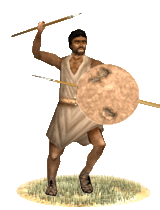 Numidian javelinmen are fast moving skirmishers trained from infancy in the use of the javelin for hunting. They are recruited from amongst nomadic peoples who need their weapon skills to survive in harsh conditions.
Numidian javelinmen are fast moving skirmishers trained from infancy in the use of the javelin for hunting. They are recruited from amongst nomadic peoples who need their weapon skills to survive in harsh conditions.
They are best employed to harry enemies and thin their ranks with volleys of missiles. They should avoid being sucked into hand-to-hand combat, as their knives are more useful in skinning animals than killing men; also, other than a small shield they have no armour.
Historically, Numidian justice was extremely harsh on deserters and cowards: crucifixion was a common punishment.
Qala'im Numidim (Numidian Slingers)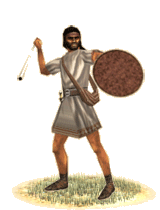 Numidian slingers came from the shepherd nomads who used their slings to protect their herds from predators. They're quite skilled with their slings, which truly is a deceptively simple weapon. One end of the sling is looped around his wrist while the other is released when the stone is launched. A sling bullet would not be seen in flight and was capable of shattering a shield or penetrating unarmored flesh to a range of about 100 metres when slung by a skilled man.
Numidian slingers came from the shepherd nomads who used their slings to protect their herds from predators. They're quite skilled with their slings, which truly is a deceptively simple weapon. One end of the sling is looped around his wrist while the other is released when the stone is launched. A sling bullet would not be seen in flight and was capable of shattering a shield or penetrating unarmored flesh to a range of about 100 metres when slung by a skilled man.
Numidian slingers are best used as light skirmishers. With no armor and very simple melee weapons, they rush forward toward the enemy to pepper them with stones, only to flee when threatened.
Historically, slingers seem to have been used in almost all corners of the world in some form and North Africa was no exception.
Hand slings are very easy and cheap to make, and yet they are a respectable weapon. They generally consisted of a single long strip of leather or woven wool, with a central "pocket" for the stone. The longer the sling, the greater its range.
Numidian Cavalry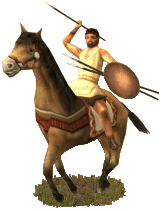 Numidia produces some of the finest cavalry in all Africa, if not the Western Mediterranean world. Armed with javelins, these mounted skirmishers can be a nightmare for an opponent as it can prove practically impossible to pin them down in combat. Their tactics are to pelt the enemy with deadly volleys of javelins, and then swiftly retreat when charged. If the enemy stand, they are slaughtered with volleys of javelins, and if they run the Numidian cavalry can ride them down! Numidia produces some of the finest cavalry in all Africa, if not the Western Mediterranean world. Armed with javelins, these mounted skirmishers can be a nightmare for an opponent as it can prove practically impossible to pin them down in combat. Their tactics are to pelt the enemy with deadly volleys of javelins, and then swiftly retreat when charged. If the enemy stand, they are slaughtered with volleys of javelins, and if they run the Numidian cavalry can ride them down!
Instinctive riders, the Numidians are famed for not using a saddle or reins, using only a stick to direct their horses. Nevertheless, they maneuver with the "grace of a flock of birds". Having adapted to the broken expanses of their homelands, Numidian cavalry have great stamina, and they are also experts in their form of the Cantabrian circle attack.
Kasatim Numidim (Numidian Archers)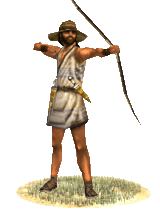 Ever since the dawn of our people, we have fought from a distance. With sling and javelin we conquered the sands, only the cowardly settled people behind their walls resisting our might. When the Phoenicians came, they conspired with our settled cousins and drove us into our desert homeland. To our shame, the newcomers had a weapon that could outperform our traditional arms. But we adapted, we adopted, and we gained prominence again. With their composite bows in our hands, we became the most feared and sought after archers in the Western Mediterranean. We wear none of the coward's armor, for it slows us in battle. Our stout Canaanite bows deliver death from afar, sending heavy arrows tearing through the ranks of the armored enemy. With a hat-helm protecting us from the harshness of the sun, we can deliver volley after volley of indirect fire. When the enemy is routed, we descend upon him like ravenous hyenas, and bash their heads in with our cudgels. If attacked up close, we can give a good enough account of ourselves, as our weapons will tackle all but the most heavily armored infantry, but we believe this is a waste of good archers. Use us wisely, general, and remember that we can win battles for you if employed properly. Ever since the dawn of our people, we have fought from a distance. With sling and javelin we conquered the sands, only the cowardly settled people behind their walls resisting our might. When the Phoenicians came, they conspired with our settled cousins and drove us into our desert homeland. To our shame, the newcomers had a weapon that could outperform our traditional arms. But we adapted, we adopted, and we gained prominence again. With their composite bows in our hands, we became the most feared and sought after archers in the Western Mediterranean. We wear none of the coward's armor, for it slows us in battle. Our stout Canaanite bows deliver death from afar, sending heavy arrows tearing through the ranks of the armored enemy. With a hat-helm protecting us from the harshness of the sun, we can deliver volley after volley of indirect fire. When the enemy is routed, we descend upon him like ravenous hyenas, and bash their heads in with our cudgels. If attacked up close, we can give a good enough account of ourselves, as our weapons will tackle all but the most heavily armored infantry, but we believe this is a waste of good archers. Use us wisely, general, and remember that we can win battles for you if employed properly.
Historically, the Numidian peoples lacked all but the simple bow until the arrival of Phoenicians at the end of the Bronze Age. Though it took some time, Numidians began to take up the bow with tremendous vigor. Soon, Carthage itself was replacing Phoenician archers with Numidian, and sending the former to become Marines in her great navy. Numidian archers were battle winners for the Romans as well, giving extremely good accounts of themselves under Caesar and against the Celts and Germans who resisted the onslaught of Rome.
Gldgmtk (Numidian Nobles)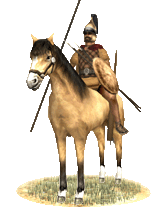 The Numidian Nobles are the high ranking class of Numidia. Trained in the hit and run tactics of their lower caste comrades they also wield heavier equipment and armour. These heavier cavalry are capable bodyguards and can be effective on the charge but they are not on the same class as the heavy cavalry of other lands. Their greatest use lies in their speed, maneuverability, and accuracy with their javelins. The Numidian Nobles are the high ranking class of Numidia. Trained in the hit and run tactics of their lower caste comrades they also wield heavier equipment and armour. These heavier cavalry are capable bodyguards and can be effective on the charge but they are not on the same class as the heavy cavalry of other lands. Their greatest use lies in their speed, maneuverability, and accuracy with their javelins.
Historically, in Numidia there was a class of nobles that ruled under the chiefs and kings and later under the sole king of Numidia. These nobles existed in both parts of Numidia, Numidia as it is known today which was dominated by the Massylians, and further north west where the area was dominated by the Masaesylian Numidians. These nobles often acted as the bodyguards and royal soldiers of the king, particularly under the reign of Jugurtha. In Sallust’s account of the Jugurthine war he mentions that in a route, only the Royal Cavalry could be counted upon to remain at the King’s side and not disperse into the countryside. The term GLDGMTK used here is from the Libyan dialect spoken by the Numidians and comes from several noble titles on inscriptions from the town of Thugga. The title translates loosely as 'Prefect of Fifty'. The other common title in Thugga was 'Chief of One Hundred'. The Numidian kings later chose to use Spanish and Gaulish mercenaries as their bodyguards instead of relying on the noble class.
Iberian Milites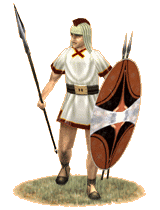 These men are occasional warriors that are levied when there is dire need for it. Recruited from all professions of Iberian society, they form a surprisingly reliable and versatile militia. As many warriors in Iberia, they use the usual combination of javelin + spear to fight. Although ill-equipped light spearmen, as their only protection is given by their sinew helms and their traditional large oval shields, their skirmishing abilities and speed makes them a nuisance in many situations if used properly. Although not as reliable as more permanent or experienced warriors like Caetratii or Scutarii, they are handy to reinforce the line or when springing tactical ambushes on enemy units. Even though they are mostly untrained, in accordance with most men in the Iberian peninsula they are no strangers to the disputes among tribes and are on a much higher level of skill and morale than other levied troops. These men are occasional warriors that are levied when there is dire need for it. Recruited from all professions of Iberian society, they form a surprisingly reliable and versatile militia. As many warriors in Iberia, they use the usual combination of javelin + spear to fight. Although ill-equipped light spearmen, as their only protection is given by their sinew helms and their traditional large oval shields, their skirmishing abilities and speed makes them a nuisance in many situations if used properly. Although not as reliable as more permanent or experienced warriors like Caetratii or Scutarii, they are handy to reinforce the line or when springing tactical ambushes on enemy units. Even though they are mostly untrained, in accordance with most men in the Iberian peninsula they are no strangers to the disputes among tribes and are on a much higher level of skill and morale than other levied troops.
Historically, the militias were mostly organized among the southern Iberians as a way to respond to sudden unexpected pillage incursions of other tribes, that came mostly from the poorer northern, mountainous regions of Iberia. This permanent state of alert throughout the decades creates harder, higher skilled men and, even if only "occasional" warriors, they were known to have far greater resilience in battle than expected for levy infantry.
Balearic Light Infantry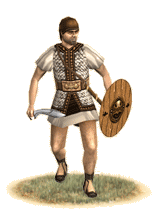 These hardy warriors from the Balearic Islands are elite amongst Carthage's mercenaries, and their cost reflects this. Most Carthaginian commanders will tell you that this price is well worth it though, for they form some of the best light infantry the world over. They are highly skilled and well disciplined from the hard lives that most have had and their serving as mercenaries as a primary career. They are great skirmishers and throw their javelins with practiced precision, often to deadly effect. When they are finished with these, they can fight as reliable light infantry, since they have small shields and are armed with falcata swords. Along with their poorer comrades fro the Balearic Islands who fight as slingers, these men are outstanding mercenaries. These hardy warriors from the Balearic Islands are elite amongst Carthage's mercenaries, and their cost reflects this. Most Carthaginian commanders will tell you that this price is well worth it though, for they form some of the best light infantry the world over. They are highly skilled and well disciplined from the hard lives that most have had and their serving as mercenaries as a primary career. They are great skirmishers and throw their javelins with practiced precision, often to deadly effect. When they are finished with these, they can fight as reliable light infantry, since they have small shields and are armed with falcata swords. Along with their poorer comrades fro the Balearic Islands who fight as slingers, these men are outstanding mercenaries.
Historically, Balearic Light Infantry were hand picked warriors choosen among their famous slinger brethren and trained and equipped by Carthage to form an elite skimirsher unit. Their skills as light infantry prompted the Carthaginians to use them whenever they were able to do so. At the River Trebia and at Lake Trasimene they proved able to decimate the Roman velites and cut fleeing Romans down in droves. Time and time again they were used to deadly effect against enemy skirmishers who stood almost no chance against their hail of javelins.
Balearic Slingers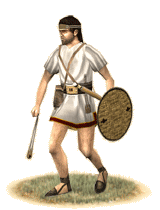 Trained from a verly early age in the use of their various types of slings and projectiles, they have reached an extremelly rare proeficiency in long range skirmishing. Fast, due to their light equipment, and with much more precision and power than other slingers, they are ideal mercenaries to have in any army that can afford their services. Contrary to most light skirmishers, their experience can be used effectivelly to strike down any unorganized foes in hand-to-hand combat. As any light infantry, they are vulnerable to cavalry. Trained from a verly early age in the use of their various types of slings and projectiles, they have reached an extremelly rare proeficiency in long range skirmishing. Fast, due to their light equipment, and with much more precision and power than other slingers, they are ideal mercenaries to have in any army that can afford their services. Contrary to most light skirmishers, their experience can be used effectivelly to strike down any unorganized foes in hand-to-hand combat. As any light infantry, they are vulnerable to cavalry.
Historically, the Balearic Slingers became famous throughout the mediterranean world due to their increadible skill in battle. These skills prompted the Carthaginians and Romans to use them whenever they were able to do so. A good example of the skill that won them renow is Diodorus Siculus' chronicle of the Battle of Eknomos in 311BC: "But when Hamilcar saw that his men were being overpowered and that the Greeks in constantly increasing number were making their way into the camp, he brought up his slingers, who came from the Balearic Islands and numbered at least a thousand. By hurling a shower of great stones, they wounded many and even killed not a few of those who were attacking, and they shattered the defensive armour of most of them. For these men, who are accustomed to sling stones weighing a mina, contributed a great deal toward victory in battle, as they practised constantly with the sling since childhood. In this way they drove the Greeks from the camp and defeated them. Their equipment for fighting consists of three slings, and of these they keep one around the head, another around the belly, and the third in the hands. In the business of war they hurl much larger stones than do any other slingers, and with such force that the missile seems to have been shot, as it were, from a catapult; consequently, in their assaults upon walled cities, they strike the defenders on the battlements and disable them, and in pitched battles they crush both shields and helmets and every kind of protective armour. And they are so accurate in their aim that in the majority of cases they never miss the target before them. The reason for this is the continual practice which they get from childhood, in that their mothers compel them, while still young boys, to use the sling continually; for there is set up before them as a target a piece of bread fastened to a stake, and the novice is not permitted to eat until he has hit the bread, whereupon he takes it from his mother with her permission and devours it!!
Iberian Caetratii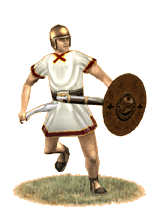 Caetratii are a deceptive type of infantry. Well able light troops, they can skirmish while softening their enemy before closing in for hand-to-hand combat. Although sometimes they use their mobility to keep them out of the reach of enemies, they are quite often able to produce very unpleasent surprises to units not normally vulnerable to light troops. Four things contribute to this capability: their agility on the battlefield, their all-metal heavy javelins ("soliferum"), the traditional Iberian ferociousness and their superb swordsmanship. They are not, however, due to their light equipment and ocasional warrior status, designed to face experienced heavy troops and should be spared to those types of combat. Their lack of anti-cavalry weapons and armour also makes them very vulnerable to such enemies. Caetratii are a deceptive type of infantry. Well able light troops, they can skirmish while softening their enemy before closing in for hand-to-hand combat. Although sometimes they use their mobility to keep them out of the reach of enemies, they are quite often able to produce very unpleasent surprises to units not normally vulnerable to light troops. Four things contribute to this capability: their agility on the battlefield, their all-metal heavy javelins ("soliferum"), the traditional Iberian ferociousness and their superb swordsmanship. They are not, however, due to their light equipment and ocasional warrior status, designed to face experienced heavy troops and should be spared to those types of combat. Their lack of anti-cavalry weapons and armour also makes them very vulnerable to such enemies.
Historically, the Caetratii were one of the most numerous type of troops in Iberian armies. They were multi-purpose light infantry made up of non-professional soldiers that filled several roles generally reserved to various types of troops. Although most Iberians were not professional soldiers, they were very used to constant tribal warfare and, as such, became skilled and resolute. Caetratii were known for their unique style of swordsmanship that employs two specific types of equipment: a curved heavy-tipped sword known as "falcata" and the small, agile buckler the Romans called "caetra". Hannibal lavished upon his Caetratii, and many of them wore white linen tunics with a crimson border..
Iberian Scutarii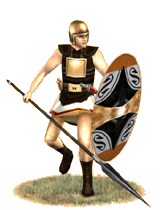 These Iberian spearmen are referred to as Scutarii by the Romans because of their large oval shields (the Latin word for shield being "Scutum"). They are well-equipped medium spearmen, being armed with the dreaded all-metal [I]soliferum[/I], a spear as their main weapon, a short straight sword and a small dagger for backup. They protect themselves with a combination of leather armour and bronze breapsplate. When all this equipment is put together you are left with an extremely versatile and quick infantry. As more permanent warriors than the Caetratii, they are more experienced and skilled, as well as better equipped and protected, generally forming the main line in Iberian armies. They use their "soliferum" before closing in for hand-to-hand combat. Although being considered by enemies as heavier troops then the Caetratii, they are, nevertheless, fast and come in handy when springing tactical ambushes on enemy units. Most Iberian warriors were known for their determination and skill and Scutarii are no exception. They are, with the traditional Iberian ferociousness, quite determined. These Iberian spearmen are referred to as Scutarii by the Romans because of their large oval shields (the Latin word for shield being "Scutum"). They are well-equipped medium spearmen, being armed with the dreaded all-metal [I]soliferum[/I], a spear as their main weapon, a short straight sword and a small dagger for backup. They protect themselves with a combination of leather armour and bronze breapsplate. When all this equipment is put together you are left with an extremely versatile and quick infantry. As more permanent warriors than the Caetratii, they are more experienced and skilled, as well as better equipped and protected, generally forming the main line in Iberian armies. They use their "soliferum" before closing in for hand-to-hand combat. Although being considered by enemies as heavier troops then the Caetratii, they are, nevertheless, fast and come in handy when springing tactical ambushes on enemy units. Most Iberian warriors were known for their determination and skill and Scutarii are no exception. They are, with the traditional Iberian ferociousness, quite determined.
Historically, the design of the later Roman legionary sword (or "gladius") was influenced by the blades carried by these men (known by the Romans as "gladius hispanniensis"). This design was adopted after Roman armies had faced large formations of Scutarii during the First Punic War.
Iberian Curisii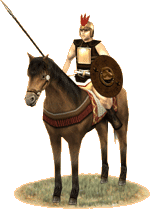 The Curisi are no different from most cavalrymen in Iberia. They are surprisingly good horsemen for a country with common rough terrain. Riding their agile, resilient Iberian horses they are good medium cavalry that are able to perform the role of shock against light troops. They wear bronze helmets and chest plates combined with leather armor, which gives them staying power in a melee contest. They carry the normal "falcata" and "caetra" combination of the Iberian tribes, which allows them to hold their own in a melee situation, although being more adept at spearing down fleeing enemies. They are armored and fast enough to stand up to most light and medium cavalry and some medium infantry, but will generally get cut to pieces by heavier spear infantry or cavalry. A good commander will take this into account. The Curisi are no different from most cavalrymen in Iberia. They are surprisingly good horsemen for a country with common rough terrain. Riding their agile, resilient Iberian horses they are good medium cavalry that are able to perform the role of shock against light troops. They wear bronze helmets and chest plates combined with leather armor, which gives them staying power in a melee contest. They carry the normal "falcata" and "caetra" combination of the Iberian tribes, which allows them to hold their own in a melee situation, although being more adept at spearing down fleeing enemies. They are armored and fast enough to stand up to most light and medium cavalry and some medium infantry, but will generally get cut to pieces by heavier spear infantry or cavalry. A good commander will take this into account.
Historically, the Iberian Curisii were excellent medium cavalry, being used by the Carthaginians, due to their agility, in a more versatile screening role than heavier cavalry. Iberian tribes used them in the same task on occasions of open confrontation, but preferred to take advantage of their stealth before using them in a surprise charge against enemy units, as all Iberian horses were trained to be quiet and silent. This skillful training of Iberian horses combined well with hit and run surprise tactics. Due to the lack of quality of Roman cavalry, they almost always had an advantage that was muted somewhat with the arrival of mercenaries from Numidia and the eastern steppe. In addition, the Curisii demonstrated their great ability to chase down light cavalry, making them truly a unit deserving of the fame given them.
Equites Caetratii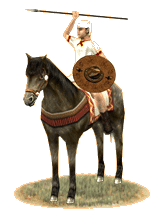 The Equites Caetrati are a very useful light skirmishing cavalry. Their surefooted, agile Iberian horses and ability to fight in a melee for a limited duration make up for their lack of armour or heavier weaponry. The Equites Caetratii are armed with several javelins and the standard Iberian "falcata" and "caetra" combination. They are very good horsemen, but do not have any armor at all other than their shields and caps. This could be a disadvantage to less hardy horsemen, but the Equites Caetratii make up for it by trading protection for agility, stealth and resistance. They are excellent skirmishing cavalry, able to carry many javelins and hurl them at enemy formations while staying out of that formation’s reach. The Equites Caetrati are a very useful light skirmishing cavalry. Their surefooted, agile Iberian horses and ability to fight in a melee for a limited duration make up for their lack of armour or heavier weaponry. The Equites Caetratii are armed with several javelins and the standard Iberian "falcata" and "caetra" combination. They are very good horsemen, but do not have any armor at all other than their shields and caps. This could be a disadvantage to less hardy horsemen, but the Equites Caetratii make up for it by trading protection for agility, stealth and resistance. They are excellent skirmishing cavalry, able to carry many javelins and hurl them at enemy formations while staying out of that formation’s reach.
Historically, Equites Caetratii were used many times to great effect by the Carthaginians. The Iberians used them more as stealthy, mobile guerrilla troops to harass and cut down a few unwary enemies before disappearing back into the hills. This was possible due to one of the surprising characteristics in Iberian armies: their peculiar training of horses. They were taught to keep silent and laying down, in all situations when their rider told them to. As such, many of the deceptive ambushes performed by Iberian tribes were even more surprising to the incautious enemy.
Iberian Lancearii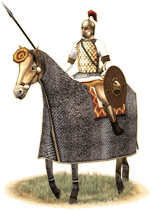 These hardy Iberians are among the choicest units available to a Carthaginian commander. They are a good all-purpose heavy cavalry, and they have a staying power on the battlefield that is simply unmatched by all but the most elite cavalry forces. They do not suffer from the same morale problems that the other Iberian troops in the service of a foreign power do since they are usually lavished upon by their commanders and their officers marry into Carthaginian or Liby-Phoenician families. They wear good quality mail armor and carry long Iberian style ovular shields. This combined with their use of a cavalry spear and falcata make them ideal cavalry for both the charge and fierce melee. These are probably the most versatile heavy cavalry in the world, and their status in the Carthaginian army proves this. These hardy Iberians are among the choicest units available to a Carthaginian commander. They are a good all-purpose heavy cavalry, and they have a staying power on the battlefield that is simply unmatched by all but the most elite cavalry forces. They do not suffer from the same morale problems that the other Iberian troops in the service of a foreign power do since they are usually lavished upon by their commanders and their officers marry into Carthaginian or Liby-Phoenician families. They wear good quality mail armor and carry long Iberian style ovular shields. This combined with their use of a cavalry spear and falcata make them ideal cavalry for both the charge and fierce melee. These are probably the most versatile heavy cavalry in the world, and their status in the Carthaginian army proves this.
Historically, the Iberian heavy cavalry was the most instrumental unit aside from the African Infantry at the battle of Cannae. They showed their martial prowess to an extreme degree by driving both the Roman and Allied heavy cavalry off the battlefield, turning and proceeding to drive the Roman light cavalry off the battlefield, then turning once more to completely surround the Roman infantry. Most cavalry would have been content with simply chasing after the Roman heavy cavalry. It takes a great deal of discipline to turn thrice, all without a commander of note during the battle! After ten years of fighting in Italy two thirds of these men were still at Hannibal’s side!
Dorkim Shardanim (Sardinian Infantry)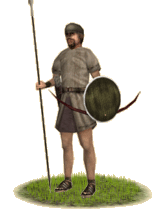 The Dorkim Shardanim (Sardinian Infantry) are drawn from the tribes of the Nuragi, a people who lived in Sardinia since an ancient time. They fight using a combination of spears and bow, and are prone to tribal skirmishing tactics; as such, their best attribute is to fight with bow at range and withdraw to safety behind stronger melee troops. Being tribal warriors, they are not prone to fighting in long engagements, and are more accustomed to hit-and-run tactics. They are unarmored, have only a buckler, and, as such, unlikely to stand long in a melee even if they were bolder.
The Dorkim Shardanim (Sardinian Infantry) are drawn from the tribes of the Nuragi, a people who lived in Sardinia since an ancient time. They fight using a combination of spears and bow, and are prone to tribal skirmishing tactics; as such, their best attribute is to fight with bow at range and withdraw to safety behind stronger melee troops. Being tribal warriors, they are not prone to fighting in long engagements, and are more accustomed to hit-and-run tactics. They are unarmored, have only a buckler, and, as such, unlikely to stand long in a melee even if they were bolder.
Historically, the Nuragi, or Nuraghics, were the ancient inhabitants of Sardinia. They constructed Nuraghe, stone towers, for which they are named, and lived in a tribal society. Their families organized into tribes, organized into larger clans, under the control of a patriarch, who was technically a subject of the Carthaginians. They persisted under Carthaginian rule for some decades, until the death of the last patriarch around approximately 210 BC, when the Nuragi, who had been steadily dissolving culturally due to importation of foreign goods and practices, were fully absorbed into the culture of the island's actual rulers.
|
 |
|
 |






















|
 |
|
|
 |
 |
© Copyright, Europa Barbarorum. All rights reserved. |
 |
 |
|